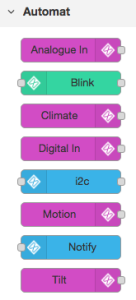How can you encourage the rapid uptake of new IoT devices and hardware?
The customer: A manufacturer of wearable IoT hardware devices based in Sweden
The need: they wanted to offer their customers a programming toolkit that allowed them to rapidly develop apps that exploited their wearable hardware.
How they used FRED: they bundled the FRED service with their hardware and added a set of hardware specfic nodes that made it easy to program specific device features.
Overview
If you are building and selling new IoT hardware or devices that are designed to be used by third parties in their products, then you need to make sure that your hardware can be quickly adopted and used in the new product. Traditionally, manufacturers shipped an SDK with their product, but with cloud technologies, that’s no longer the only option.

An alternative is to provide your customers with access to a cloud based rapid development environment – like FRED. Some of the key benefits are:
- Modern visual programming tool with a wide range of built in modules
- No need to maintain and update SDKs, a single cloud service is accessed by all your customers
- Maintain a relationship with your customers – understand their usage as they work with the platform
- Develop and dynamically update new features and fixes all in one place
To help our customer, we white labeled FRED, offering a branded version with a tailored UI that their customers accessed separately from the main FRED service. We worked with the customer to develop a set of hardware specific nodes that accessed and managed specific features of their hardware, these were then provisioned into the standard FRED palette of pre-built nodes allowing their customers to quickly build new IoT applications and services that made best use of the advanced features of the wearable hardware.
The result: the customer could focus on their added-value, the hardware, safe in the knowledge that they were offering a full programming environment for their customers that exploited key features of the hardware – and allowed developers to prototype new products quickly.